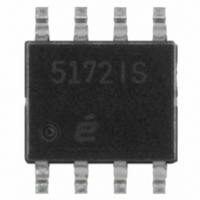EL5172IS Intersil, EL5172IS Datasheet - Page 11

EL5172IS
Manufacturer Part Number
EL5172IS
Description
IC LINE RCVR 250MHZ SGL 8-SOIC
Manufacturer
Intersil
Datasheet
1.EL5172ISZ.pdf
(15 pages)
Specifications of EL5172IS
Amplifier Type
Differential
Number Of Circuits
1
Slew Rate
800 V/µs
Gain Bandwidth Product
100MHz
-3db Bandwidth
250MHz
Current - Input Bias
6µA
Voltage - Input Offset
7000µV
Current - Supply
5.6mA
Current - Output / Channel
95mA
Voltage - Supply, Single/dual (±)
4.75 V ~ 11 V, ±2.38 V ~ 5.5 V
Operating Temperature
-40°C ~ 85°C
Mounting Type
Surface Mount
Package / Case
8-SOIC (3.9mm Width)
Lead Free Status / RoHS Status
Contains lead / RoHS non-compliant
Output Type
-
Available stocks
Company
Part Number
Manufacturer
Quantity
Price
Company:
Part Number:
EL5172ISZ
Manufacturer:
EPIC
Quantity:
12 388
Part Number:
EL5172ISZ
Manufacturer:
EL
Quantity:
20 000
Company:
Part Number:
EL5172ISZ-T7
Manufacturer:
AD
Quantity:
2 390
Part Number:
EL5172ISZ-T7
Manufacturer:
INTERSIL
Quantity:
20 000
power consumption. The amplifier's power-down can be
controlled by standard CMOS signal levels at the ENABLE
pin. The applied logic signal is relative to V
EN pin float or applying a signal that is less than 1.5V below
V
when the signal at EN pin is above V
signal is used to control the enabled/disabled function,
Figure 24 could be used to convert the TTL signal to CMOS
signal.
Output Drive Capability
The EL5172 and EL5372 have internal short circuit
protection. Its typical short circuit current is ±95mA. If the
output is shorted indefinitely, the power dissipation could
easily increase such that the part will be destroyed.
Maximum reliability is maintained if the output current never
exceeds ±60mA. This limit is set by the design of the internal
metal interconnections.
Power Dissipation
With the high output drive capability of the EL5172 and
EL5372, it is possible to exceed the +135°C absolute
maximum junction temperature under certain load current
conditions. Therefore, it is important to calculate the
maximum junction temperature for the application to
determine if the load conditions or package types need to be
modified for the amplifier to remain in the safe operating
area.
The maximum power dissipation allowed in a package is
determined according to Equation 3:
• T
• T
• θ
Assuming the REF pin is tied to GND for V
application, the maximum power dissipation actually
produced by an IC is the total quiescent supply current times
the total power supply voltage, plus the power in the IC due
to the load, or:
For sourcing, use Equation 4:
PD
PD
S
+ will enable the amplifier. The amplifier will be disabled
MAX
MAX
AMAX
JA
JMAX
= Thermal resistance of the package
=
=
= Maximum junction temperature
= Maximum ambient temperature
T
-------------------------------------------- -
V
JMAX
S
×
CMOS/TTL
I
Θ
SMAX
–
JA
T
AMAX
+
(
FIGURE 24.
V
S
+
1k
11
–
V
10k
OUT
5V
)
S
×
+ - 0.5V. If a TTL
------------------- -
R
V
LOAD
EN
OUT
S
S
+ pin. Letting the
= ±5V
i ×
EL5172, EL5372
(EQ. 3)
(EQ. 4)
For sinking, use Equation 5:
PD
Where:
• V
• I
• V
• R
• I
• i = Number of channels
By setting the two PD
can solve the output current and R
overheat.
Power Supply Bypassing and Printed Circuit
Board Layout
As with any high frequency device, a good printed circuit
board layout is necessary for optimum performance. Lead
lengths should be as short as possible. The power supply
pin must be well bypassed to reduce the risk of oscillation.
For normal single supply operation, where the V
connected to the ground plane, a single 4.7µF tantalum
capacitor in parallel with a 0.1µF ceramic capacitor from V
to GND will suffice. This same capacitor combination should
be placed at each supply pin to ground if split supplies are to
be used. In this case, the V
supply rail.
For good AC performance, parasitic capacitance should be
kept to a minimum. Use of wire wound resistors should be
avoided because of their additional series inductance. Use
of sockets should also be avoided if possible. Sockets add
parasitic inductance and capacitance that can result in
compromised performance. Minimizing parasitic capacitance
at the amplifier's inverting input pin is very important. The
feedback resistor should be placed very close to the
inverting input pin. Strip line design techniques are
recommended for the signal traces.
MAX
SMAX
LOAD
S
OUT
LOAD
= Total supply voltage
=
= Maximum output voltage of the application
= Load current
= Maximum quiescent supply current per channel
= Load resistance
[
V
S
×
I
SMAX
MAX
+
(
V
OUT
equations equal to each other, we
S
- pin becomes the negative
–
V
S
LOAD
- )
×
I
LOAD
to avoid the device
]
i ×
September 14, 2010
S
- pin is
(EQ. 5)
FN7311.9
S
+







